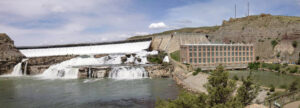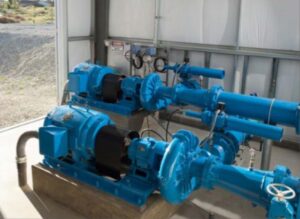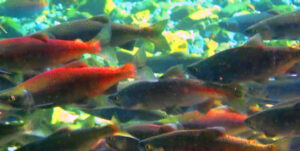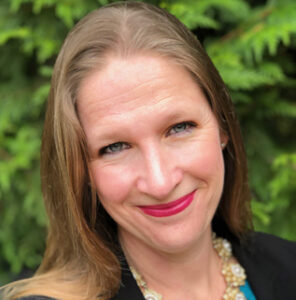The Northwest Hydroelectric Association (NWHA) is a trade association that represents independent energy producers; public and private utilities; local, state, and regional government entities; and individuals across the Northwestern United States and Canada. Its mission is to promote the region’s waterpower as a clean, efficient energy source while protecting wildlife and the environment. In this interview, NWHA Executive Director Brenna Vaughn tells Hydro Leader about the association’s history and current issues and how it helps the hydropower industry to speak with one voice on matters of pressing concern.
Hydro Leader: Please tell us about your background and how you came to be in your current position.
Brenna Vaughn: I come from a long line of hydropower workers. I am a fourth-generation hydropower employee. My great grandfather, Harold A. Linke, was the Utah state engineer. My grandfather, Harold A. Linke Jr., worked on Fontenelle Dam, the beginning of the Central Utah Project, the Weber Basin Project, and the Payson Project. My mom, Deborah Linke, worked for the Western Area Power Administration as the power marketing and rates manager for federal hydropower projects in the western United States and retired after serving for a decade as the manager of the Bureau of Reclamation’s Power Resources Office. I spent my childhood chasing power plants and transmission lines. On my 21st birthday, as a special treat only a hydro person can understand, I stuck my hand out the face of Hoover Dam on a behind-the-scenes tour. During my childhood and college years, I visited hydropower facilities in Italy, Japan, and throughout the United States. My family has been in hydro for a long time, and you could say I grew up in hydro, so it’s fun to step into that field with the NWHA.
Hydro Leader: What philosophy do you bring from that background to your current role at the NWHA?
Brenna Vaughn: My personal philosophy is that I am four things: I’m a hydropower advocate, a philanthropist, a mom, and an investor. I used to think that these four roles were siloed. As I have gotten further into my career, however, I have come to see that these four roles intersect to form a hybrid profession. I can be an investor of time and talent, I can educate kids on hydropower, I can be a mentor to a new workforce entrant, and I can educate legislators and decisionmakers about hydropower. I hope that our community continues to recognize this hybridity. We are all able to wear multiple hats, and we can add to the richness of our community and the hydropower industry by bringing more perspectives, roles, and talent into each job.
Hydro Leader: Please tell us about your philosophy regarding problem solving.

Brenna Vaughn: I am a firm believer in win-win situations. The more we collaborate and communicate, the more likely we are to find a shared solution. Typically, everyone can get something positive out of collaboration. I see that all the time at the NWHA: When we get into a tough situation or a tough topic, the more we can talk and get to the core of the issue, the more we find that we all care about the environment and clean energy and that there is a shared solution. That is empowering to our members.
Hydro Leader: Please tell us about the NWHA and its history.
Brenna Vaughn: The NWHA was incorporated in 1981, so this year marks our 40th year as an association. It was formed by a group of folks who were interested in building new hydropower projects in the Northwest. It was a small group of six individuals, including legislators, consultants, and a paper mill executive. It was originally called the Northwest Small Hydroelectric Association, but when larger utilities and other developers joined, we became the NWHA. We’re a 501(c)(6)nonprofit organization.
Hydro Leader: What is the mission of the association?
Brenna Vaughn: The NWHA is dedicated to promoting the region’s waterpower as a clean, efficient energy source while protecting the fisheries and environmental quality that characterize our Northwest region.
Hydro Leader: What are your top issues?
Brenna Vaughn: We are working on a lot of licensing reform processes to allow upgrades and new projects to be installed within more-realistic time frames. We are also seriously looking into powering nonpowered dams in the Northwest and implementing small hydro projects, while also protecting the large projects that provide over 90 percent of the renewable energy to the residents of the Northwest. We are a loud and proud voice for hydropower. During the past year, our organization has worked in our members’ interests regarding Columbia River issues related to total maximum daily temperature loading, Clean Water Act regulations, and other rules and resolutions. That advocacy work takes up a big chunk of my time. Another key issue that we are working on is communication. One of the main things I have worked on during my first year with the NWHA is getting our members to align and synchronize their communications about hydropower.

Hydro Leader: What are some of the main public relations challenges for hydropower owners and operators?
Brenna Vaughn: The population of the Northwest has grown quickly in recent years, with transplants from all over the country. These new arrivals move to our region for clean air, outdoor recreation, and good employment opportunities. Sometimes those new arrivals are unaware of the role that hydropower plays in maintaining these attributes— for instance, that it is the number 1 source of renewable power here in the Northwest. Misinformation and myths about hydropower are widespread, particularly in younger generations like the millennials and Gen Z.
Hydro Leader: What are some of the main misconceptions in the public mind concerning hydropower?
Brenna Vaughn: A lot of people don’t understand how hydropower works; how it helps integrate other renewable energy sources; or the many nonpower benefits it provides, including shoreline, recreation, environmental mitigation, and habitat enhancement. Millennials and Gen Z folks are likely to have grown up learning about other renewables, such as solar and wind, in school, but not about the many benefits of hydropower. Millennials and Gen Z also tend to live in urban areas, where hydropower isn’t necessarily well known.
Hydro Leader: What are the key messages that hydro owners and operators need to communicate to the public?
Brenna Vaughn: We worked with the Northwest River Partners and the Public Power Council to establish six key messages that are important for hydropower owners and operators to communicate to the public. First, hydropower provides 90 percent of the region’s renewable, carbon-free electricity. It is critical to our fight against climate change. Second, hydropower acts as a giant green battery that allows us to add wind and solar power to the grid. Third, advanced fish passage technologies at hydropower dams can greatly improve salmon survival. Fourth, as we move away from fossil fuel resources, hydropower will likely be key to avoiding regional blackouts. Fifth, most Northwest hydropower reaches our communities through not-for-profit, community-owned utilities. Finally, the loss of clean and affordable hydropower would unfairly burden vulnerable communities. We try to make sure that those messages are getting out and being heard again and again in our communities.
Hydro Leader: How do you apply those six basic points to various kinds of hydropower and various audiences?
Brenna Vaughn: Hydropower represents a lot of different technologies and facilities, from enormous generating facilities down to really small in-conduit plants on irrigation projects. The communication surrounding hydropower changes as we look at different types of generation. Although these top six messages are generally the same, we need to specialize them for each type of project.
When we talk about something like conduit hydropower, we typically need to focus on how an irrigation system works and explain that water is being pumped from one place to another in a water basin and that by harnessing water in a conduit, we can return more water into the basin. We need to communicate that closed-loop hydropower systems, sometimes known as pumped-storage hydropower systems, often have minimal environmental effects. These projects typically don’t have negative effects on our communities. When a closed system is pumping water up and down a hill, it’s not taking water out of a watershed, but simply reusing the same water that is already stored in the two reservoirs.
When we talk about large hydropower projects, we need to focus on how we are modernizing our hydropower fleet to improve our plants’ efficiency and environmental aspects. Large hydropower underpins and leverages other renewable resources, which are valued partners. Large hydro is the unsung hero of grid resiliency.
It is interesting that small hydro often goes unnoticed on our rivers. It does not require large impoundments or infrastructure and has limited environmental effects. It’s important to communicate that within our communities.
Hydro Leader: Is there anything that you would like to add about hydropower as a renewable energy source?

Brenna Vaughn: I think that, up until recently, renewable energies were competing with each other rather than leveraging one another’s strengths. We are seeing a big shift toward integrating our approaches and working together collaboratively rather than competitively. For example, we are seeing wind farms located near pumped storage and small hydro working with communities to integrate solar projects. I think there is a lot to gain from these types of collaborative efforts.
Hydro Leader: What trends do you see in hydropower technology and in hydropower’s role in the overall energy mix?
Brenna Vaughn: It is exciting to see how much potential hydropower holds for the nation and especially for our region. Currently, the amount of hydropower produced in the Northwest is enough to power roughly 15 Seattle-sized cities. There is a ton of opportunity to grow that. For example, we could power all the nonpowered dams in the region, and we are working toward that. Currently, there are 71 nonpowered dams in our membership territory that have shown potential for the development of power. What keeps hydropower relevant in the future energy mix is that it is clean, affordable, and renewable. As other renewables grow, we need a good renewable baseload capacity so that when clouds cover a solar array or the wind stops blowing, there is a backstop. Right now, the best technology solution for that is hydropower.
Hydro Leader: What should Congress know about hydropower?
Brenna Vaughn: Congress needs to hear loud and clear that our clean energy future rests on integrating renewables and that hydropower is the cornerstone to successfully doing that.
Hydro Leader: How has the COVID‑19 pandemic affected the types of events your association is scheduling?
Brenna Vaughn: Given the COVID‑19 pandemic, the NWHA has been working with our membership to gather in small, impromptu virtual coffee chats on fast-breaking issues. It’s one thing to have a workshop twice a year, but more frequent gatherings are important. A recent example were the blackouts in the California market. We got together that same week to debrief, talk about the initial lessons, and keep our members informed. When the fires erupted in Oregon in September, we gathered our utility members together the following week to go over lessons learned and to share information.
We also hold regional workshops that focus on topics specific to the Northwest. The next one will be our 2021 annual conference, which will be held as a virtual event. The event will include all the elements that people have come to expect from the NWHA, such as highly accessible technical content and great networking opportunities. We’re bringing it to our attendees in a format called Hydro Camp, which will be a really fun spin on our event. It will be held on February 17–18, 2021. Information for this event is on our website, www.nwhydro.org.
Hydro Leader: Please tell us about your work across international borders.
Brenna Vaughn: Here in the Northwest, there are many opportunities to work across state lines and across entire river basins to coordinate research and fish studies and to streamline licensing. This is a replicable model. There is also a shared interest in the territories we serve in Canada, especially in the headwaters of the Columbia River. I continue to be amazed by the ingenuity and innovation that is visible worldwide. The Northwest can learn from that. When we see floating solar arrays on a reservoir abroad, that’s something we can note and learn from.
Hydro Leader: How can people join or become more involved in the NWHA?
Brenna Vaughn: The NWHA is a grassroots organization that relies on its membership. If people want to learn more about the NWHA and the spaces we are working in, they can visit our website. If what we are doing is interesting to them, we welcome new members!
Brenna Vaughn is the executive director of the Northwest Hydroelectric Association. She can be contacted at brenna@nwhydro.org.


